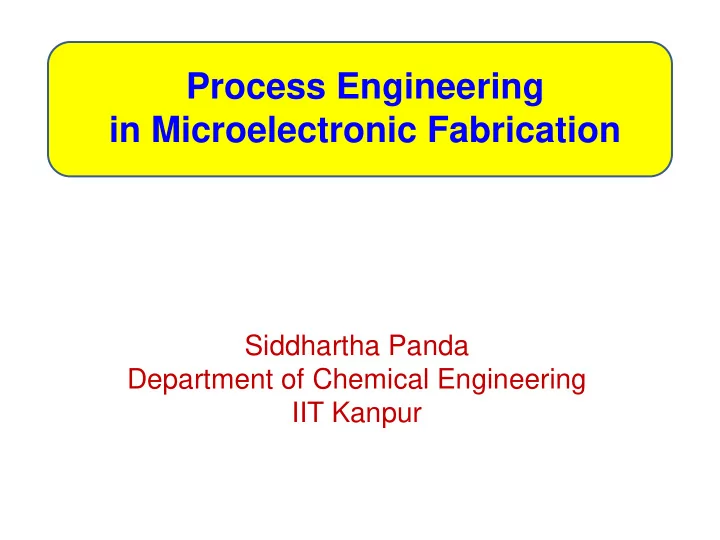

Process Engineering in Microelectronic Fabrication Siddhartha Panda Department of Chemical Engineering IIT Kanpur
Electronic chips Miniturization Drivers Trends Logic Memory Trends Enhanced capabilities
Evolution Developments of the semiconductor industry Structure developments Process developments Chip/Circuit/System design Andy Grove Process Engineering BS, CHE, 1960 PhD, CHE, 1963 Sequence of unit processes Enabled by process engineers * Process development * Equipment design/fab. * Integration
Unit Processes and role of chemical technology • Layering oxidation kinetics film growth vapor depositions (plasma enhanced, chemical, physical etc.) epitaxy Mass, momentum, energy, species balance Electromagnetic field (Poisson’s eqn) • Patterning ( wet and dry) etching – dielectrics, semiconductors (silicon), metals resist development polymer processing •Doping chemical, ion implantation diffusion Not just processes •Heating but also equipment designs heat transfer Hot plates, IR •Planarization 2 phase flow chemical and mechanical polishing (slurry)
Some unit processes * Crystal Growth and Wafer Fabrication * Oxidation (thermal) * Dopant Diffusion * Ion Implantation * Rapid Thermal Processing * Chemical Mechanical Planarization * Physical Vapor Deposition * Chemical Vapor Deposition * Lithography * Wet Etching * Plasma Deposition and Plasma Etching An example DRAM chips 16 Mbit (~1991) 64 Mbit (~1996) Non-planar Advent of CMP (early 1990s) enabled *denser packing (Courtesy – Siemens) * more metallization layers
Crystal Growth * How to control the diameter of the Quartz Tube boule? Rotating Chuck * What is the maximum velocity of pulling the crystal from the melt? Seed Crystal Growing Crystal (boule) Analysis at the melt interface Heat transfer RF or Resistance Heating Coils Mass transfer Cz Molten Silicon Dopants - segregation (Melt) Crucible
Concentration profiles Need to formulate a model describing incorporation of dopants into growing crystals C k = Moving molten zones S o (boundaries) C L
Oxidation stagnant oxide silicon bulk gas gas layer flow C g C s Mass transport Reactions C o C i F 1 F 2 F 3
Dopant diffusion Drift diffusion ∂ ∂ ∂ 2 C C C = − D v ∂ ∂ ∂ 2 t x x Concentration dependence of D Defect dependence ∂ ∂ ∂ C C = + C C eff * I V D D f f = eff D I V * * C C ∂ ∂ ∂ I V t x x Material properties Transport phenomena RTP Ion stopping distance R 0 0 0 P dE dE dE ∫ ∫ ∫ ∫ = = = = R dx + + P dE / dx S S f ( E ) f ( E ) n e 1 2 0 E E E 0 0 0
Physical Vapor Deposition substrate substrate source material heat heat Surface chemistry surface reaction direct reaction between incoming species and surface site Eley-Rideal mechanism reaction between surface species Langmuir-Hinselwood mechanism δ δ J = = = ζ i R J J ν + r i i 1 k / k − − + ( E d – E r E E ) / RT 0 d 1 e d r r d s ν 0 r
Surface diffusion ν − Λ = 2RT ( E E ) / RT 0 s a e c s ν 0 c Thermodynamics (statistical mech) Transport Reactions Parameters – Macroscale Atomic phenomena Transport, Kinetic, ….
Chemical Vapor Deposition Equipment design
Wet etching
Plasma processing – deposition and etching etch stop PLASMA RF heating electron generation Electron impact with atoms more electrons + ions + fragments Cascading reactions species generation time 1 / 2 ε kT λ = 0 e D 2 n e e Knudsen diffusion Surface reactions * Transport Momentum, Mass, Energy, Charge * Reactions (Panda et al., Microelectronic Engineering, 2004)
Advances in equipment design Etch - Sub 70 nm Si trenches Tunable gas distribution Dual zone chuck Specialized gases Multiple frequency configuration AMAT – Mariana RTP Heat transfer Filamant design/configuration Uniform heat flux AMAT
Thoughts • Process engineering • PE in Microelectronic fabrication -- India perspective * Demand for electronic goods * Domestic manufacturing * Need for trained manpower
Recommend
More recommend